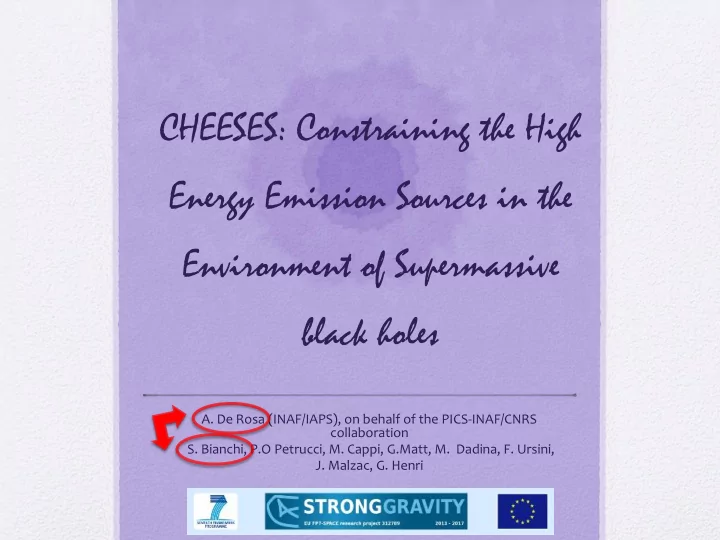

CHEESES: Constraining the High Energy Emission Sources in the Environment of Supermassive black holes A. A. De Rosa (INAF/IAPS), on behalf of the PICS-INAF/CNRS collaboration B. S. Bianchi, P.O Petrucci, M. Cappi, G.Matt, M. Dadina, F. Ursini, C. J. Malzac, G. Henri
AGN emission model • Radio-quiet AGNs emit the bulk of their luminosity in the UV and X-ray bands • optically thick cold plasma and Elvis 1994 hot and optically thin plasma • Cold and hot phases are expected to be radiatively linked one with each other
The Cheeses project The French-Italian PICS project (INAF/CNRS): a systematic and detailed spectral analysis of the best quality data of a large sample of AGN by using the most up-to-date high energy radiative models • use realistic and up-to-to date Comptonization models to derive the physical and geometrical parameters (the temperature and optical depth) of the hot corona responsible for the hard X-ray emission in AGN • constrain the origin of the « secondary » spectral components (especially the soft X-ray excess)
Multiple OM and EPIC simultaneous observations of AGNs Analysis • Realistic Comptonization models using Simultaneous XMM-pn & OM multiple observations. Spectral Variability study. The sample • X-rays: CAIXA (Bianchi+2009): all the radio-quiet X-ray unobscured (Nh <2e22 cm -2 ) AGNs observed by XMM-Newton in targeted observations. • UV: Serendipitous Ultra-violet Source Survey XMM-SUSS2 (Page+2012) : optical/UV sources detected serendipitously by the OM/XMM-Newton in 6 filters (W2,W1,M2,U,B,V) • 70 sources (16 NLsy1,30 BLsy1, 24 no Hbeta), 253 obsID with pn and at least one OM filter
Sample global properties Flux-flux correlations Intra-band and inter-band variability NLSy1 vs BLSy1
UV vs X-ray variability Trend of variability is different between UV and soft-X
Flux-flux variability • NLSy1s exhibit larger amplitude of variation with respect to BLSy1 • The soft X-ray band seems the most variable NLSy1: FWHM(Hb)<2000 km/s BLSy1: FWHM(Hb)>2000 km/s (CAIXA, Bianchi+09)
Inter-band variability FUV/Fsoft Fsoft/<Fsoft> At Higher accretion rates the soft-X flux increases with respect to the UV
Inter-band variability …. Less evident in the 2 -10 keV band FUV/Fhard Fhard/<Fhard> NLSy1 tend to have higher L/Ledd and higher alpha_ox wrt BLSy1 (see also Jin+2012)
Single source analysis Sources with more than three EPIC and OM simultaneous observations: 9 BLSy1 8 NLSy1
Inter-band flux correlations BLSy1 NLSy1 F(0.5-2 keV) FUV FUV The different variability patterns on NLSy1 and BLSy1 may be due to variability, different components in the band, physical??
Inter-band flux variability BLSy NLSy1 FUV/F(0.5-2keV) FUV/F(0.5-2keV) At Higher accretion rates the soft- X flux increases with respect to the UV …?
simultaneous SEDs with EPIC and OM Building the SED Modelling with comptonization models: a test case
Simultaneous SEDs
Simultaneous SEDs
SED modelling Each observation is fitted with a realistic thermal Comptonization model for the continuum emission.
SED modelling Mkn509 obs1 Warm corona: optically thick, kT=.0.5 keV, Tsoft~eV Hot corona: kT~200 keV, Tsoft~150 eV
(very) Preliminary results • Soft X-rays have different trend of variability with respect to UV(W2) • In the soft X-ray and UV band the NLSy1s exhibit larger amplitude of variation with respect to BLSy1 • NLSy1 tend to have higher L/Ledd and higher alpha_ox wrt BLSy1 • The different variability patterns on NLSy1 and BLSy1 in the soft X-rays may be due to different components in the band, physical??
Work in progress • SED modelling for all the observations of the sample • Timescale variability. Further constraint for sample selection • Hard-X rays. For NGC4593 a MW campaign is ongoing (XMM/HST/NuStar)
Recommend
More recommend